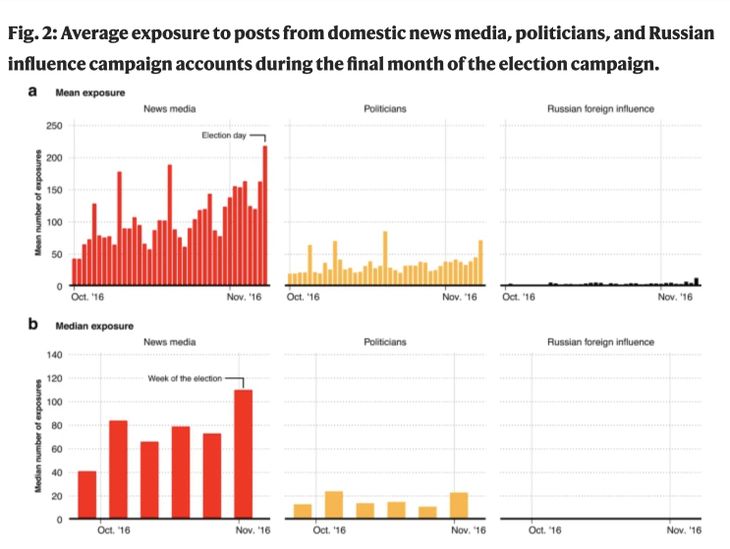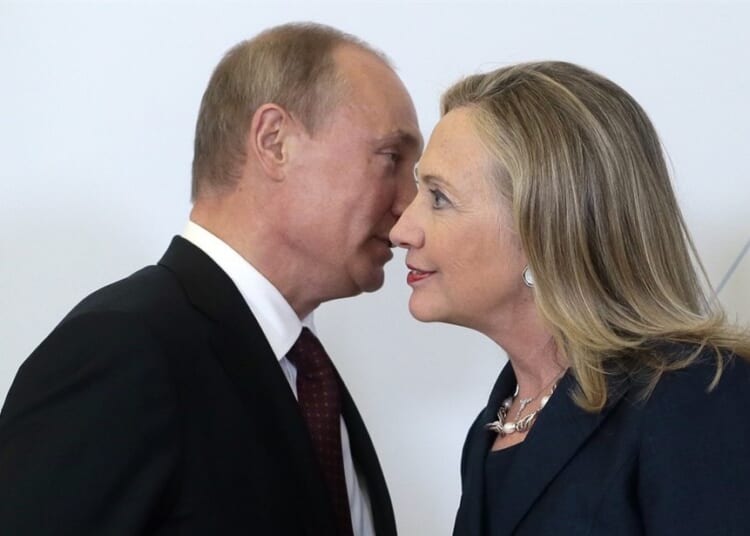An international group of political scientists did something that no MSM outlet bothered to do in the seven years since the 2016 election: study the issue.
For 3/4 of a decade, we have been subjected to story after story about Russia Russia Russia and how it stole the 2016 election through a sophisticated influence campaign designed to get Donald Trump elected. Such stories were repeated endlessly and, through clever manipulation of the facts and the dishonest utterances of Democrats, were turned into the meme that Russia “hacked” our elections, a claim for which there is no evidence at all.
There is little doubt that Russia maliciously engaged in some social media manipulation to muddy the waters and play havoc on our system, although the evidence that it was a large-scale effort is scant, and there has never been any evidence at all that it played a role in the outcome of the election. Yet nobody ever bothered to look at the evidence until last year.
In a little-heralded study–one that I found recently–some political scientists designed a study to look at the issue and found that Russian efforts in 2016 had no appreciable impact on the outcome. Still, subsequent efforts to use the accusations have since undermined faith that our elections are fair.
The paper, published in Nature Communications last year, was conducted by researchers at NYU, The University of Copenhagen, Trinity College Dublin, and the Technical University of Munich. Titled “Exposure to the Russian Internet Research Agency foreign influence campaign on Twitter in the 2016 US election and its relationship to attitudes and voting behavior,” the study did something that could have been done at any time since the 2016 elections.
What they found was fascinating–the number of exposures to the Russian posts was not insignificant, until you put that number in context. Almost nobody saw them–the mean exposure to the posts was zero–literally zero–and even for the very few people who did see them they were people who were going to vote for Trump, and the number was swamped by posts from MSM and politicians.

First, the obvious question for those not familiar with statistics: the mean is zero because the number of exposure to Twitter posts across the population is extremely high compared to the number of Russian posts; the concentration of the posts seen was among so few people that most people saw none. Statistically speaking the average number of posts anybody saw was zero.
Who saw these posts? Almost nobody followed the Russian accounts, so they spread through retweets in relatively small numbers, and as you can see by the median exposure graph, both media exposure and posts from politicians swamped anything posted by Russians. The same pattern applies to so-called “fake news” posts–much ado is made of them, but almost nobody sees any of them. For instance, I hear a lot about Q-Anon from the MSM and Democrats, but have never been exposed to an actual Q-Anon theory from a believer.
That median exposure is zero per week in the last month of the election suggests that exposure may, in general, be concentrated among a small group of users. To examine this, we present in panel b of Fig. 1 the cumulative distribution of exposure among respondents to posts from foreign influence accounts. It shows that exposure to foreign influence accounts is concentrated among a small group of respondents: 1% of respondents account for 70% of exposures to posts from Russian foreign influence accounts. Furthermore, almost all exposure is concentrated among only 10% of respondents, who account for 98% of exposures to posts from Russian foreign influence accounts. Interestingly, this concentration of exposure among a small group of users is broadly similar to patterns found in studies of exposure to fake news21,22.
Exposure among the very few people who saw the posts from Russian influence operations didn’t change votes, either. Attitudes toward Clinton and Trump didn’t change.
As estimates in the first panel indicate, the relationship between the number of posts from Russian foreign influence accounts that users are exposed to and voting for Donald Trump is near zero (and not statistically significant). This is the case whether the outcome is measured as vote choice in the election itself; the ranking of Clinton and Trump on equivalent survey questions across survey waves; and with the broader measure capturing whether voting behavior more generally favored Trump or Clinton through voting abstentions, changes in vote choice, or voting for a third party. The signs on the coefficients in each case are also negative, both for the count and binary measure, a result that would be inconsistent with a relationship of exposure being favorable to Trump.
Statistically speaking the effect was zero, and the nonsignificant finding (the minor change in attitudes measured by not statistically significant) showed a very minor increase in negative attitudes toward Trump. In other words, if the posts did anything at all, they made people slightly less likely to vote for Trump. But those results were within the statistical margin for error.
Taking our analyses together, it would appear unlikely that the Russian foreign influence campaign on Twitter could have had much more than a relatively minor influence on individual-level attitudes and voting behavior for four related reasons. First, we find that exposure to posts from Russian foreign influence accounts was concentrated among a small group of users, with only 1% of users accounting for 70% of all exposures. Second, exposure to Russian foreign influence tweets was overshadowed by the amount of exposure to traditional news media and US political candidates. Third, respondents with the highest levels of exposure to posts from Russian foreign influence accounts were those arguably least likely to need influencing: those who identified themselves as highly partisan Republicans, who were already likely favorable to Donald Trump. Fourth, we did not detect any meaningful relationships between exposure to posts from Russian foreign influence accounts and changes in respondents’ attitudes on the issues, political polarization, or voting behavior. Each of these findings is not independently dispositive. Jointly, however, we find concordant evidence between exposure to Russian disinformation—which is both lower and more concentrated than one might expect to be impactful—and the absence of a relationship to changes in attitudes and voting behavior.
In other words, the influence operation accomplished almost nothing.
Nothing, except for the fact that the subsequent efforts of the Democrats and the MSM to use its existence as proof the election was “hacked” undermined faith in the results of the election, increased polarization, and led to deep distrust in our electoral system.
It was the Democrats and MSM, in other words, who turned the 2016 election into a societal disaster, creating polarization in the country unseen in 150 years.
As is so often the case these days it is the Democrats’ disinformation campaign that causes the real harm, because Democrats and the MSM have direct and constant access to the information people get. By distorting the information landscape they create division where it need not exist.
Russia didn’t harm America in 2016. Democrats have been on a campaign to do so since that election. And that campaign, unlike the Russian one, has worked.

